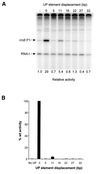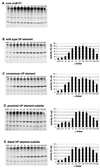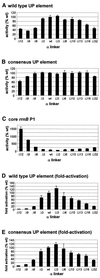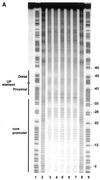UP element-dependent transcription at the Escherichia coli rrnB P1 promoter: positional requirements and role of the RNA polymerase alpha subunit linker
- PMID: 11600705
- PMCID: PMC60210
- DOI: 10.1093/nar/29.20.4166
UP element-dependent transcription at the Escherichia coli rrnB P1 promoter: positional requirements and role of the RNA polymerase alpha subunit linker
Abstract
The UP element stimulates transcription from the rrnB P1 promoter through a direct interaction with the C-terminal domain of the RNA polymerase alpha subunit (alphaCTD). We investigated the effect on transcription from rrnB P1 of varying both the location of the UP element and the length of the alpha subunit interdomain linker, separately and in combination. Displacement of the UP element by a single turn of the DNA helix resulted in a large decrease in transcription from rrnB P1, while displacement by half a turn or two turns totally abolished UP element-dependent transcription. Deletions of six or more amino acids from within the alpha subunit linker resulted in a decrease in UP element-dependent stimulation, which correlated with decreased binding of alphaCTD to the UP element. Increasing the alpha linker length was less deleterious to RNA polymerase function at rrnB P1 but did not compensate for the decrease in activation that resulted from displacing the UP element. Our results suggest that the location of the UP element at rrnB P1 is crucial to its function and that the natural length of the alpha subunit linker is optimal for utilisation of the UP element at this promoter.
Figures







Similar articles
-
Structural requirements for the interdomain linker of alpha subunit of Escherichia coli RNA polymerase.Biochemistry. 2000 May 23;39(20):6243-9. doi: 10.1021/bi000020d. Biochemistry. 2000. PMID: 10821700
-
Molecular anatomy of a transcription activation patch: FIS-RNA polymerase interactions at the Escherichia coli rrnB P1 promoter.EMBO J. 1997 Jan 2;16(1):154-62. doi: 10.1093/emboj/16.1.154. EMBO J. 1997. PMID: 9009276 Free PMC article.
-
DNA flexibility of the UP element is a major determinant for transcriptional activation at the Escherichia coli acetate promoter.Nucleic Acids Res. 1997 Feb 15;25(4):713-8. doi: 10.1093/nar/25.4.713. Nucleic Acids Res. 1997. PMID: 9016619 Free PMC article.
-
Activation of P2 late transcription by P2 Ogr protein requires a discrete contact site on the C terminus of the alpha subunit of Escherichia coli RNA polymerase.J Mol Biol. 1997 Nov 21;274(1):1-7. doi: 10.1006/jmbi.1997.1390. J Mol Biol. 1997. PMID: 9398509 Review.
-
The Escherichia coli RNA polymerase alpha subunit: structure and function.Curr Opin Genet Dev. 1995 Apr;5(2):197-203. doi: 10.1016/0959-437x(95)80008-5. Curr Opin Genet Dev. 1995. PMID: 7613089 Review.
Cited by
-
Downregulation of the Escherichia coli guaB promoter by FIS.Microbiology (Reading). 2008 Jun;154(Pt 6):1729-1738. doi: 10.1099/mic.0.2008/016774-0. Microbiology (Reading). 2008. PMID: 18524927 Free PMC article.
-
RNA polymerase and an activator form discrete subcomplexes in a transcription initiation complex.EMBO J. 2006 Aug 23;25(16):3784-90. doi: 10.1038/sj.emboj.7601261. Epub 2006 Aug 3. EMBO J. 2006. PMID: 16888625 Free PMC article.
-
Predicting the strength of UP-elements and full-length E. coli σE promoters.Nucleic Acids Res. 2012 Apr;40(7):2907-24. doi: 10.1093/nar/gkr1190. Epub 2011 Dec 8. Nucleic Acids Res. 2012. PMID: 22156164 Free PMC article.
-
Design, construction and characterization of a set of insulated bacterial promoters.Nucleic Acids Res. 2011 Feb;39(3):1131-41. doi: 10.1093/nar/gkq810. Epub 2010 Sep 15. Nucleic Acids Res. 2011. PMID: 20843779 Free PMC article.
-
Upstream binding of idling RNA polymerase modulates transcription initiation from a nearby promoter.J Biol Chem. 2015 Mar 27;290(13):8095-109. doi: 10.1074/jbc.M114.628131. Epub 2015 Feb 2. J Biol Chem. 2015. PMID: 25648898 Free PMC article.
References
-
- Zhang G., Campbell,E.A., Minakhin,L., Richter,C., Severinov,K. and Darst,S.A. (1999) Crystal structure of Thermus aquaticus core RNA polymerase at 3.3 Å resolution. Cell, 98, 811–824. - PubMed
-
- Ebright R.H. (2000) RNA polymerase: structural similarities between bacterial RNA polymerase and eucaryotic RNA polymerase II. J. Mol. Biol., 304, 687–698. - PubMed
-
- Darst S.A., Roberts,J.W., Malhotra,A., Mark,M., Severinov,K. and Severinova,E. (1997) Pribnow box recognition and melting by Escherichia coli RNA polymerase. In Eckstein,F. and Lilley,D.M.J. (eds), Nucleic Acids and Molecular Biology, Vol. 11. Springer-Verlag, Berlin, pp. 27–40.
Publication types
MeSH terms
Substances
Grants and funding
LinkOut - more resources
Full Text Sources
Molecular Biology Databases

